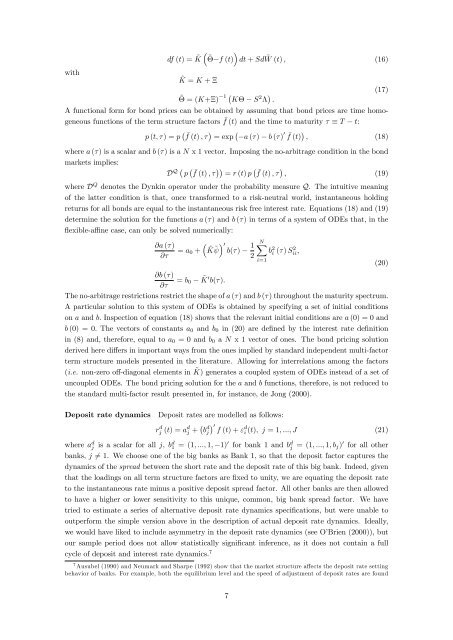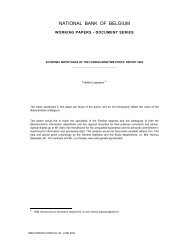A multi-factor model for the valuation and risk management of ...
A multi-factor model for the valuation and risk management of ...
A multi-factor model for the valuation and risk management of ...
You also want an ePaper? Increase the reach of your titles
YUMPU automatically turns print PDFs into web optimized ePapers that Google loves.
with<br />
df (t) = K ~ <br />
~<br />
~K = K + <br />
f (t)<br />
<br />
dt + Sd ~ W (t) ; (16)<br />
~ = (K+) 1 K S 2 :<br />
A functional <strong>for</strong>m <strong>for</strong> bond prices can be obtained by assuming that bond prices are time homogeneous<br />
functions <strong>of</strong> <strong>the</strong> term structure <strong>factor</strong>s f (t) <strong>and</strong> <strong>the</strong> time to maturity T t:<br />
(17)<br />
p (t; ) = p f (t) ; = exp a () b () 0 f (t)<br />
<br />
; (18)<br />
where a () is a scalar <strong>and</strong> b () is a N x 1 vector. Imposing <strong>the</strong> no-arbitrage condition in <strong>the</strong> bond<br />
markets implies:<br />
D Q p f (t) ; = r (t) p f (t) ; ; (19)<br />
where D Q denotes <strong>the</strong> Dynkin operator under <strong>the</strong> probability measure Q. The intuitive meaning<br />
<strong>of</strong> <strong>the</strong> latter condition is that, once trans<strong>for</strong>med to a <strong>risk</strong>-neutral world, instantaneous holding<br />
returns <strong>for</strong> all bonds are equal to <strong>the</strong> instantaneous <strong>risk</strong> free interest rate. Equations (18) <strong>and</strong> (19)<br />
determine <strong>the</strong> solution <strong>for</strong> <strong>the</strong> functions a () <strong>and</strong> b () in terms <strong>of</strong> a system <strong>of</strong> ODEs that, in <strong>the</strong><br />
‡exible-a¢ ne case, can only be solved numerically:<br />
@a ()<br />
@<br />
<br />
= a 0 + ~K ~ 0 1 b()<br />
2<br />
NX<br />
b 2 i () S2 ii ;<br />
@b ()<br />
= b 0 K ~ 0 b():<br />
@<br />
The no-arbitrage restrictions restrict <strong>the</strong> shape <strong>of</strong> a () <strong>and</strong> b () throughout <strong>the</strong> maturity spectrum.<br />
A particular solution to this system <strong>of</strong> ODEs is obtained by specifying a set <strong>of</strong> initial conditions<br />
on a <strong>and</strong> b: Inspection <strong>of</strong> equation (18) shows that <strong>the</strong> relevant initial conditions are a (0) = 0 <strong>and</strong><br />
b (0) = 0: The vectors <strong>of</strong> constants a 0 <strong>and</strong> b 0 in (20) are de…ned by <strong>the</strong> interest rate de…nition<br />
in (8) <strong>and</strong>, <strong>the</strong>re<strong>for</strong>e, equal to a 0 = 0 <strong>and</strong> b 0 a N x 1 vector <strong>of</strong> ones. The bond pricing solution<br />
derived here di¤ers in important ways from <strong>the</strong> ones implied by st<strong>and</strong>ard independent <strong>multi</strong>-<strong>factor</strong><br />
term structure <strong>model</strong>s presented in <strong>the</strong> literature. Allowing <strong>for</strong> interrelations among <strong>the</strong> <strong>factor</strong>s<br />
(i.e. non-zero o¤-diagonal elements in K) ~ generates a coupled system <strong>of</strong> ODEs instead <strong>of</strong> a set <strong>of</strong><br />
uncoupled ODEs. The bond pricing solution <strong>for</strong> <strong>the</strong> a <strong>and</strong> b functions, <strong>the</strong>re<strong>for</strong>e, is not reduced to<br />
<strong>the</strong> st<strong>and</strong>ard <strong>multi</strong>-<strong>factor</strong> result presented in, <strong>for</strong> instance, de Jong (2000).<br />
i=1<br />
(20)<br />
Deposit rate dynamics<br />
Deposit rates are <strong>model</strong>led as follows:<br />
r d j (t) = a d j + b d j<br />
0<br />
f (t) + "<br />
d<br />
i (t); j = 1; :::; J (21)<br />
where a d j is a scalar <strong>for</strong> all j, bd 1 = (1; :::; 1; 1) 0 <strong>for</strong> bank 1 <strong>and</strong> b d j = (1; :::; 1; b j) 0 <strong>for</strong> all o<strong>the</strong>r<br />
banks, j 6= 1. We choose one <strong>of</strong> <strong>the</strong> big banks as Bank 1, so that <strong>the</strong> deposit <strong>factor</strong> captures <strong>the</strong><br />
dynamics <strong>of</strong> <strong>the</strong> spread between <strong>the</strong> short rate <strong>and</strong> <strong>the</strong> deposit rate <strong>of</strong> this big bank. Indeed, given<br />
that <strong>the</strong> loadings on all term structure <strong>factor</strong>s are …xed to unity, we are equating <strong>the</strong> deposit rate<br />
to <strong>the</strong> instantaneous rate minus a positive deposit spread <strong>factor</strong>. All o<strong>the</strong>r banks are <strong>the</strong>n allowed<br />
to have a higher or lower sensitivity to this unique, common, big bank spread <strong>factor</strong>. We have<br />
tried to estimate a series <strong>of</strong> alternative deposit rate dynamics speci…cations, but were unable to<br />
outper<strong>for</strong>m <strong>the</strong> simple version above in <strong>the</strong> description <strong>of</strong> actual deposit rate dynamics. Ideally,<br />
we would have liked to include asymmetry in <strong>the</strong> deposit rate dynamics (see O’Brien (2000)), but<br />
our sample period does not allow statistically signi…cant inference, as it does not contain a full<br />
cycle <strong>of</strong> deposit <strong>and</strong> interest rate dynamics. 7<br />
7 Ausubel (1990) <strong>and</strong> Neumark <strong>and</strong> Sharpe (1992) show that <strong>the</strong> market structure a¤ects <strong>the</strong> deposit rate setting<br />
behavior <strong>of</strong> banks. For example, both <strong>the</strong> equilibrium level <strong>and</strong> <strong>the</strong> speed <strong>of</strong> adjustment <strong>of</strong> deposit rates are found<br />
7
















